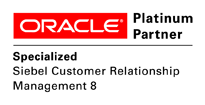Past Event: Nov 09, 2023
Retrouvez Boxfusion Consulting lors de l’événement Oracle Applications Unlimited Days, en France
1 min read

Author: Geraint Thomas
3 min read
Automated testing with Siebel has traditionally been difficult and expensive. Specialised software was required to interact with the Active X control of the Siebel HI application. It also normally required testers to write complex scripts in a proprietary language which was time consuming and the maintainability of the automated test scripts was poor, meaning suites of test scripts quickly became out of date.
As we have talked about in our previous posts on Siebel Open UI, the Active X control is no more. Boxfusion have been at the forefront of innovation using Open UI to improve Siebel usability and user experience, but we have also been looking at how Open UI can lower the overall cost of ownership of Siebel and also the cost of Siebel development. With Open UI, Siebel is a fully web compliant application meaning we can exploit open source web testing frameworks such as Selenium. While Selenium does not incur a licensing fee, it would still require a test analyst to write complex code in a language such as Java and therefore would also fall foul of the associated pitfalls discussed above.
Therefore what we have done in our Open UI innovation lab is develop an abstraction so that test analysts do not need to write script. The abstraction consists of a simple Java program that we have written, that can read the test steps stored in Siebel, determine which action to take, i.e. click a button, enter text etc. as specified by the test script and then writes back to Siebel if that action was successful. In the videos below, you'll see the Java program run from the command line, receiving the Id of the test in Siebel, but this could easily be changed so that Siebel could initiate the whole process by calling the Java program as a Web Service. The last important point is that our abstraction also allows the same test script to be run on multiple browsers and in parallel to allow for an efficient and broad set of tests.
What you may notice from the video is that the framework stores the results of the test in Siebel - recording the outcome and performance of each step, it also takes a screenshot which is visible against each step in Siebel. Any issues detected can be assigned to a developer to investigate and resolve. As well as ensuring the validity of a process flow, scripts can include validation of values, checking visibility of text or images, and any number of other tests.
Fig 1. Screenshot of automated testing framework UI
Test scripts can easily be written and stored in Siebel - you can see this in the video clip below. To write a test script is a simple process; for each step we need to define the Siebel control we want to select and the action to perform. For example, to identify the control a test analyst using the chrome browser needs only to right click on the control in Siebel, select inspect element, and then copy its unique identifier. To improve the speed at which scripts are created, scripts can be copied and modified enabling a broad and comprehensive test suite to be rapidly developed.
To run the test, a Java program is launched with the ID of the test created in Siebel. It extracts the test (via a web service call from Siebel) and interrupts the test scripts. It writes the outcome of each step, its performance and a screenshot of the outcome of each step back into Siebel. Hopefully you can see from all of this, where Open UI has enabled greater opportunities for increased agility within Oracle's Siebel product!
If you would like more information on this approach or on Open UI in general, why not contact us, or call us now on +44 203 2834315, to discuss how your organisation can benefit from Open UI.

You can also read more about our OpenUI Services here.
1 min read
6 min read
4 min read